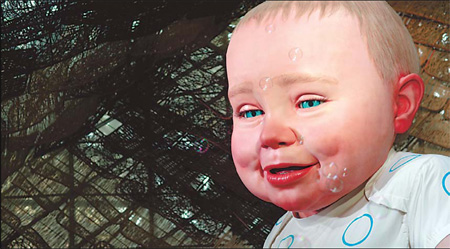Spain Pavilion: a basket of fun
 |
| The giant 6.5-meter-tall Migueln at the Spanish Pavilion. |
Resembling a giant, hand-woven rattan basket, the Spain Pavilion has captured tourists' attention by offering a spectacular vision that combines the latest technology with natural products.
"The main message we've brought to Shanghai is cooperation in terms of making wicker, a natural fiber, a handicraft of global tradition used as much in the East as in the West. This is the main connection between Spain and China," said Mara Tena, commissioner general of the Spain Pavilion.
Nicknamed the "Spanish Basket" by the Chinese media, the pavilion is built using a steel tubing skeleton that supports 8,524 large wicker panels.
"The Spain Pavilion has transformed the Expo into the world's largest demonstration of the incredible versatility, durability and sustainability of bamboo and rattan," said Coosje Hoogendoorn, director general of the International Network for Bamboo and Rattan.
"It represents the most incredible use of rattan I've ever seen. It uses 8,500 individual rattan panels, handmade by craftsmen in Shandong province to create a giant, hand-woven rattan basket, which, to me, resembles the skirt of a flamenco dancer."
The pavilion's three exhibition rooms, 2,500 square meters in total area, tell of the changes in Spanish cities under the slogan "From the City of Our Parents to the City of our Children".
"In search of a Spanish model for city living, the journey ends with a look, both emotional and responsible, to the future that we want to leave for our children," said Tena.
Inspired by the general Expo theme, "Better City, Better Life", the contents of the Spain Pavilion have been put in the hands of three of the most distinguished directors of Spanish cinema, Bigas Luna, Basilio Martn Patino and Isabel Coixet, with three rooms titled Origin, Cities and Children.
"The aim is to transmit a contemporary and modern image of Spain through comprehensible and attractive contents for the vast Chinese public that may be unfamiliar with Spain," Tena said.
Inside, the Spain Pavilion is memorable and delightful.
"I've really enjoyed my visit. I love the first room. It combines spectacular installations, special effects and flamenco performances," said Josefine Kehl, a 22-year-old university student from Germany.
Another main attraction, Children, is in the third room where a giant 6.5-meter-tall baby named Migueln breathes, blinks, gestures and dreams about his environment.
"I was a bit scared at the beginning when I saw the giant baby, which is like a real moving baby. Still, I found out many kids are so fond of taking photos with the baby, who turns his head between fragile soap bubbles," said a woman surnamed Hou from Henan.
As one of the most popular pavilions in Zone C, the Spain Pavilion has had an average of 35,000 visitors daily since the opening of the Expo. About 75 staff from China and Spain work in the pavilion as a team providing services for tourists.
"Working as a guide is an exhausting task, full of challenges, but I think it's the perfect chance for me to apply what I've learned into practice," said Shen Yi, a 29-year-old from Shanghai who works as a host and guide in the Spain Pavilion and has studied in Spain.
The Spain Pavilion also expresses the idea of the plaza as a meeting and communication point, with a strong program presenting the best of its art and culture and its capacity for innovation and technology.
"We've got performances on the Expo main stage, cinema, dance, theater, a nightly show in the pavilion auditorium and theme weeks each dedicated to one of the Spain's autonomous communities," Tena said.
 0
0 







Go to Forum >>0 Comments